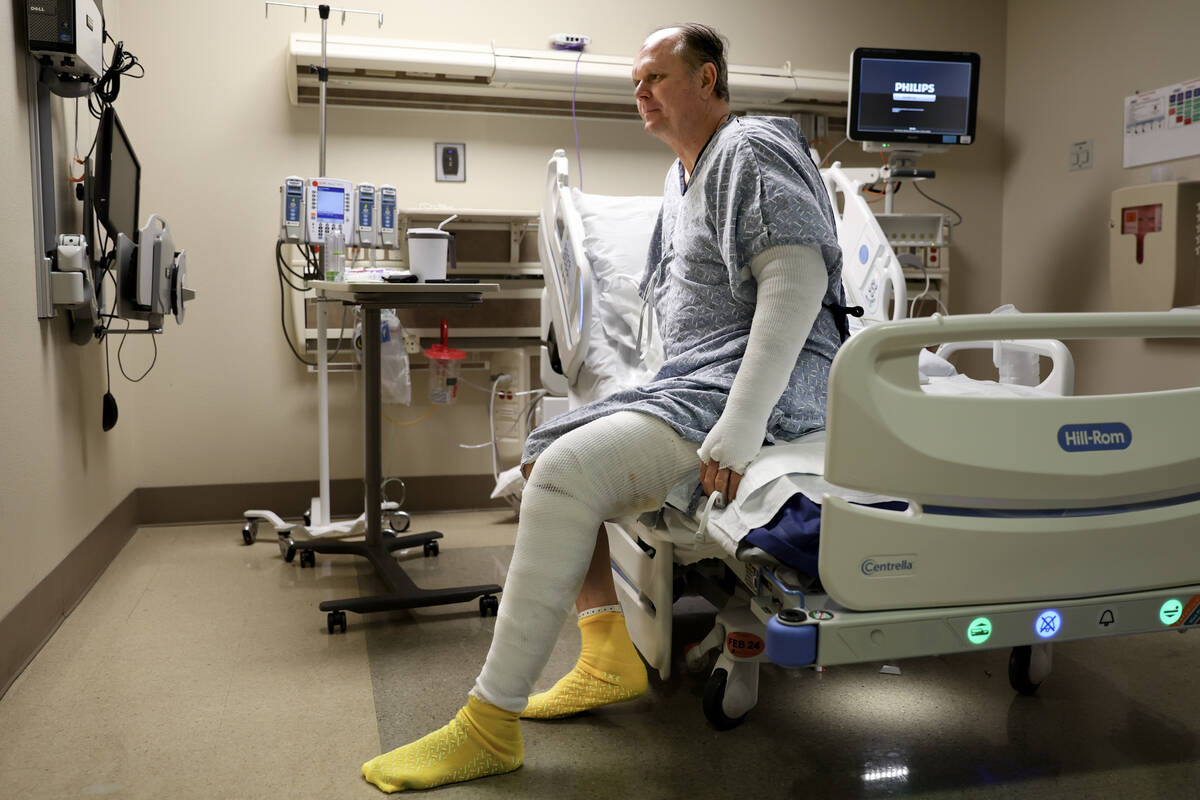‘A busy summer’: 23 hospitalized for pavement burns at UMC in June

Stephen Cantwell was betting on horses at the Wynn sportsbook on June 21, winning and taking shots of tequila in celebration.
About six shots deep, Cantwell decided to go get sushi at Fashion Show Mall, which is just across the street from the Wynn. The next thing he remembers is waking up in the hospital with burns on nearly 7 percent of his body.
“I definitely passed out and fell on the pavement,” said Cantwell, 59, who said he was found unconscious by bystanders on the sidewalk outside the mall. “I don’t know how long I was there. I woke up here in the hospital, and then I look over and I got all these blisters on me.”
Cantwell was one of at least 23 people hospitalized for pavement burns at University Medical Center’s Lions Burn Care Center in June, according to UMC spokesperson Scott Kerbs.
Last June, only three people were admitted to the burn care center for pavement burns.
June 2024 was the hottest June in Las Vegas history “almost any way you slice it,” according to the National Weather Service. The average daily high temperature in June, for example, was 106.2 degrees. That’s 1.2 degrees hotter than the June average high temperature has ever been.
And July is Las Vegas’ hottest month. As of July 5, the average daily high temperature this month was 110.8. The hottest average high temperature for July in Las Vegas history was 109.4.
“A dangerous and historic heatwave is just getting started across the area,” the Las Vegas forecast office of the National Weather Service said in a forecast discussion posted online Saturday afternoon. Saturday’s high was 115.
But Sunday could be a record-breaker. That’s when the temperature in Las Vegas could hit 118, weather service meteorologist Barry Pierce said. Tuesday and Wednesday could also see highs of 118, Pierce said.
It has never been that hot in Las Vegas before.
“We’re bracing ourselves for a busy summer,” said Syed Saquib, a burn surgeon and the medical director of the burn care center.
Saquib cares for burn injuries of all kinds, including ones caused by flames, chemicals, electrical currents and hot surfaces, like pavement. Pavement burns are often much deeper than other kinds of burns, he said.
Sometimes, all of the tissue of a body part, except muscle and bone, must be removed from the wounded area due to a pavement burn, according to Saquib. After suffering a third- or fourth-degree burn, a person will typically need surgeries to remove the unhealthy tissue and cover the injured area by skin grafting, he said.
Cantwell said he suffered second- and third-degree burns on his left arm, backside and leg. He needed multiple surgeries and was discharged from University Medical Center on July 4, he said.
Burn injuries aren’t supposed to be exposed to water, so Cantwell won’t be able to take a shower for quite a while. He also needs to avoid exposing his injuries, as well as recently healed patches of skin, to sunlight, he said. It’ll be about a year until Cantwell can resume swimming, his preferred method of exercise.
The first horse race he bet on got underway at 11:30 a.m., Cantwell said. He thinks he left the casino to grab sushi an hour and a half later. The temperature at Harry Reid International Airport was 102 at 1 p.m. on June 21, according to the National Weather Service.
Saquib said pavement in summertime in a place like Las Vegas can get hotter than 160 degrees. Just “a few minutes” of contact with pavement at that temperature can cause a severe burn, he added.
When he collapsed, Cantwell was wearing a short-sleeved shirt and shorts, he said. Pavement can burn skin through clothing, especially thin garments, no problem, according to Saquib.
Saquib said he couldn’t be certain why so many more people were admitted to the burn care center for pavement burns this June, compared with last June. In July and August of 2023, there were 26 and 13 hospitalizations, respectively, Kerbs said.
Those who have suffered severe burns from pavement this year have, by and large, gotten their injuries in the same ways as people in the past, Saquib said.
Many of Saquib’s pavement burn patients are people who’ve passed out on the pavement, he said. People pass out for all sorts of reasons. Maybe they are under the influence or badly dehydrated. A person could have a seizure when no one is around to see him or her fall.
Occasionally, those with advanced diabetes who can’t really feel the soles of their feet will walk barefoot on the pavement and suffer burns because they don’t think it’s so hot, Saquib said. People who fall on the pavement and can’t get up quickly enough may suffer burns. Sometimes kids get pavement burns by walking outside barefoot and not realizing they can hurt themselves that way.
Jim Andersen, chief of code enforcement for Clark County Animal Protection Services, said the county receives complaints every year about people walking their dogs on pavement during times of extreme heat.
If a pet owner can’t hold a hand on the pavement for more than seven seconds, it’s too hot for a dog’s paws, Andersen said. Dog shoes, if their soles are thick enough, can protect a pet from pavement burns, he added.
Saquib said humans can protect themselves from pavement burns by wearing shoes with thick soles as well. Drinking plenty of water and seeking shade when outdoors may prevent one from passing out from dehydration.
Saquib keeps a small cloth in his car to use when gripping the steering wheel, if it’s too hot when he hops in the car, he said. He will also use a cloth to turn the knob on the front door of his apartment.
“Any metallic surface in the desert heat can heat up and can cause burns,” Saquib added.
Contact Peter Breen at pbreen@reviewjournal.com.